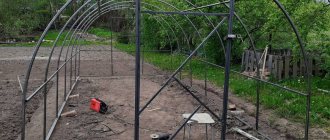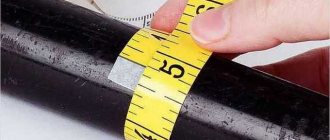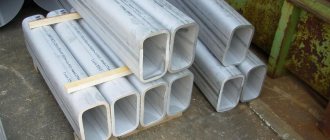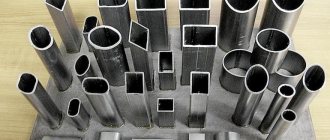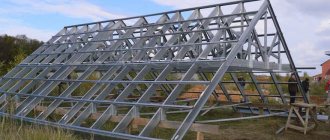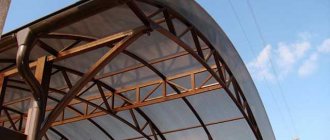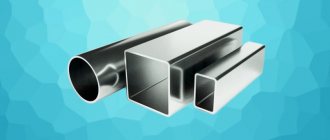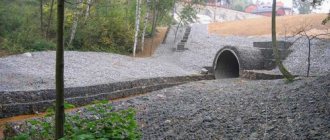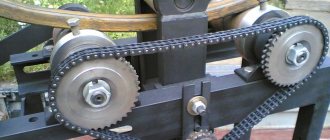Metal bending is one of the key metalworking methods. The technological process makes it possible to obtain a curved product from a flat straight blank. One type of metal bending is radius bending. It involves the use of press brakes that are capable of giving the sheet or pipe the desired angle. Bending allows you to avoid stamping and welding and obtain products of the required shape at a lower cost.
Figure 1 - Bending along the radius
Demand for the technology of “metal bending along a radius”
By bending metal at angles and different radii, the following is obtained:
- elements of curtain facades;
- metal furniture;
- cornices;
- interior details;
- advertising signs, etc.
Figure 2 - Radial bending of a channel
The need for radius bending of metal is often encountered in everyday life, during construction and repair. For example, when you need to bend a profile pipe at a certain angle without unnecessary deformations and kinks. It is unlikely that you will be able to do this on your own. High-quality work can only be done with the help of a professional machine. The task of the machines is to perform plastic deformation without damaging the metal. The technology allows you to take into account the characteristics of the workpiece and produce products with different technical data.
Bending in dies using pressing
Bending of blanks no longer than 70 centimeters can be done using stamping. In this case, hydraulic or mechanical presses are used. This method allows the production of structural elements with complex shapes.
Pressing blanks is the most expensive bending method. However, its productivity is the highest. This method allows us to produce a wide range of products.
Pipe bending machine equipment
Pipe bending on an industrial scale is carried out using machines.
Bending by rolling. The most common machines are those that bend products using rolling. The most commonly used equipment is with three rolls, designed for bending long workpieces. It can be used to produce spiral pipes.
The product moves through rollers, the location of which determines its bending radius. At the same time, it is compressed on both sides by a deforming cylinder. It is located between the rollers, so that it is possible to bend the workpiece in weight. Rollers serve as a support during metal processing.
Compression processing
Often in production, machines are used that bend workpieces with a small radius using a compression method. They process workpieces of small and large cross-sections. The process occurs with local heating of the products and simultaneous axial pressure on them.
- bed with a heater located on it;
- support roller;
- pairs of pincer clamps, the first of them is bending and rotary, the second is sedimentary.
The device is capable of bending elements at an angle of 180º. It clamps the workpieces with a constant force, regardless of their cross-section and the value of the axial force generated at the epicenter of deformation during bending of the product. The equipment can process square and rectangular profiles.
Rotary stretch bending
Rotary pipe drawing is carried out on machines with electric or hydraulic supports for moving pressure rollers. The latter serve to obtain the desired configuration and thickness of the produced element.
With rotary drawing, products are produced from hollow rotating rods, deformed by rollers along a moving mandrel. Nowadays, CNC rotary drawing machines are used in most cases. Their program takes into account the resistance of the material when it is deformed. When manufacturing products, the corresponding GOST is used.
How to prepare sheet metal for radius bending
Before using machines for radius bending of sheet metal, it is important to properly prepare for the process:
- analyze the characteristics of the future product;
- calculate the force required;
- select the standard size of the equipment;
- make workpiece drawings;
- calculate deformation parameters;
- design tooling.
An important stage is selecting the material and testing it for suitability. Once the bending parameters have been determined, you need to understand whether the existing workpieces are suitable for the job. To do this you need:
- determine the plastic characteristics of the product, compare the results with the real stresses that arise during bending;
- determine the minimum bending radius of sheet metal at which the risk of cracks is not high;
- identify the possibility of workpiece deformation after pressure treatment, especially if the final configuration is complex.
The results of such a study may vary. After checking everything, experts make the appropriate decisions:
- replace the workpiece with a more plastic one;
- heat the metal before deformation;
- carry out softening heat treatment.
Important: before bending, you need to determine the smallest angle, minimum radius, and spring angle of the selected sheet of metal.
Bending parameters and force calculator
We present to your attention a modern online calculator for calculating the necessary parameters for bending metal on a press brake. Using simple values, you can determine the required opening of the matrix for selection, and on its basis - the necessary parameters for the radius and minimum flange. You will also receive the tonnage (maximum force) required for bending to ensure the capabilities and resources of your equipment. We warn you in advance that all values are theoretical and reference values for primary analysis.
S—material thickness in mm, user defined
α — bending angle in degrees, specified by the user
V - matrix opening in mm, V=value, generated parameter
h—minimum flange length in mm, generated parameter
Ri - minimum bending radius in mm, generated parameter
F - tonnage of a press brake for bending a given thickness according to a matrix in tons, the total tonnage is formed depending on the given bending length in mm (parameter L)
How to bend sheet metal along a radius
Bending operations are the main methods of processing sheet metal. First, the sheets are prepared in bending machines in the procurement areas. Often, workpieces are cut into strips - strips of a certain width, which are then deformed according to plan.
Figure 3 - Sheet bending
When performing radius bending of sheet metal, a number of features should be taken into account:
- As a result of pressure treatment, the metal becomes fibrous. To prevent cracks from appearing, bending is carried out across the fibers. The sheet can also be bent so that the bend line is at an angle of 45° to the direction of the fibers.
- Metal has fluidity. If you exceed its limit, the sheet will tear.
- Changes occur at the bending site: the metal becomes thinner, deformed in the cross section, the neutral layer shifts towards a smaller radius (initially it is located either in the middle or in the center of gravity).
Particular difficulties arise when working with small workpieces. It is important to remember the following:
- with a small bending radius, the deformation covers most of the workpiece;
- with a large radius there is no such effect.
How to bend pipes along a radius
The concept of radius exists not only when bending sheet metal, but also when deforming pipes. The use of special equipment allows you to reduce the number of welds and improve the quality of installation.
The technology of bending steel pipes allows the workpiece to be completely or partially deformed. Along the inner radius, the hollow profile experiences a compressive force, and along the outer radius, a tensile force. The process has its own characteristics:
- when bending, some sections of the pipe may be deformed so that the alignment is disrupted;
- radial forces that stretch the outer wall can cause metal rupture;
- compressive tangential forces acting on the inner wall, with uneven bending, can cause folds to appear - corrugation of the metal.
To bend a pipe radius, you can use two main methods:
- cold;
- with preheating of the desired area.
Cold bending is used for small diameter pipes. It involves mandatory determination of the minimum bending radius.
Preheating is used to increase the ductility of the metal and reduce the risk of defects. Most often, this method is used for large diameter pipes. Carrying out work with preheating requires more time and labor.
Both methods require knowledge of technological processes. Only if the relevant norms and standards are observed is it possible to carry out radius bending without the formation of cracks or folds on the walls.
Figure 4 - Radius pipe bending
Behavior of round, square and rectangular sections, types of destruction
The thickness of the pipe walls on the outer part of the bend becomes smaller due to the fact that when stresses arise, a tensile moment appears:
- The outer wall, which has become thin, tends to bend towards the median axis of the pipe. This leads to its cross section being deformed.
- When the tensile strength of the product is exceeded, it breaks along the outer plane of bending.
The thickness of the pipe walls on the inside of the bend becomes greater due to the appearance of compressive stress. When the compressive strength of a product is exceeded, it loses local stiffness. This leads to the formation of deep folds on the inner plane of the curved pipe.
How do square and rectangular profiles behave:
- Their pipe walls are subject to maximum compressive and tensile stress, both on the outer and inner bending planes.
- The material has an increased tendency to deformation; it is difficult for the master to control it.
- The profile material on the inside of the bend is prone to vertically directed expansion. At the same time, it flows horizontally along the end of the product. These stresses press down the vertically located pipe walls. In this case, the square cross section is deformed. It takes on a trapezoidal configuration.
- Rectangular and square cross-sections do not transfer clamping forces between the bending and clamping jaws well.
- The profile tends to slide along the block at the beginning of bending. At the same time, he can rub it, which leads to wear and tear of the equipment.
Sheet metal bending radii
When deforming workpieces, it is important to know the minimum bending radii of sheet metal. For each element or alloy these indicators are different. If you do not take them into account, the workpiece can easily be damaged.
In addition to the material, the bending radius is affected by:
- type of sheets (annealed, riveted);
- position of the bend line (along or across the fibers).
Minimum bending radius of sheet metal
For example, consider the minimum metal bending radii in the table.
| Material | Annealed | Riveted | ||
| Fold line | ||||
| Across the grain | Along the fibers | Across the grain | Along the fibers | |
| Aluminum | 0,2 | 0,3 | 0,8 | |
| Copper | 0,2 | 1 | 2 | |
| Brass L68 | 0,2 | 0,4 | 0,8 | |
| Soft duralumin | 1 | 1,5 | 1,5 | 2,5 |
| Solid duralumin | 2 | 3 | 3 | 4 |
| Steel 05–08 | 0,2 | 0,2 | 0,5 | |
| Steel 8–10, St1 and St2 | 0,4 | 0,4 | 0,8 | |
| Steel 15–20, St3 | 0,1 | 0,5 | 0,5 | 1 |
| Steel 25–30, St4 | 0,2 | 0,6 | 0,6 | 1,2 |
| Steel 35–40, St5 | 0,3 | 0,8 | 0,8 | 1,5 |
| Steel 45–50, St6 | 0,5 | 1 | 1 | 1,7 |
| Stainless steel Х18Н9Т | 1 | 2 | 3 | 4 |
Maximum bending radius of sheet metal
There is no concept of a maximum bending radius. If a specialist knows exactly what the minimum bending radius of sheet metal is, then any larger options are suitable.
Calculation of sheet metal bending radius
From what was written above, it follows that the calculation of the bending radius of sheet metal is based on its parameters. The material of manufacture, the thickness of the product, the method of manufacturing the workpiece, as well as the wishes of the customer are taken into account. The latter directly depend on what product you need to receive.
